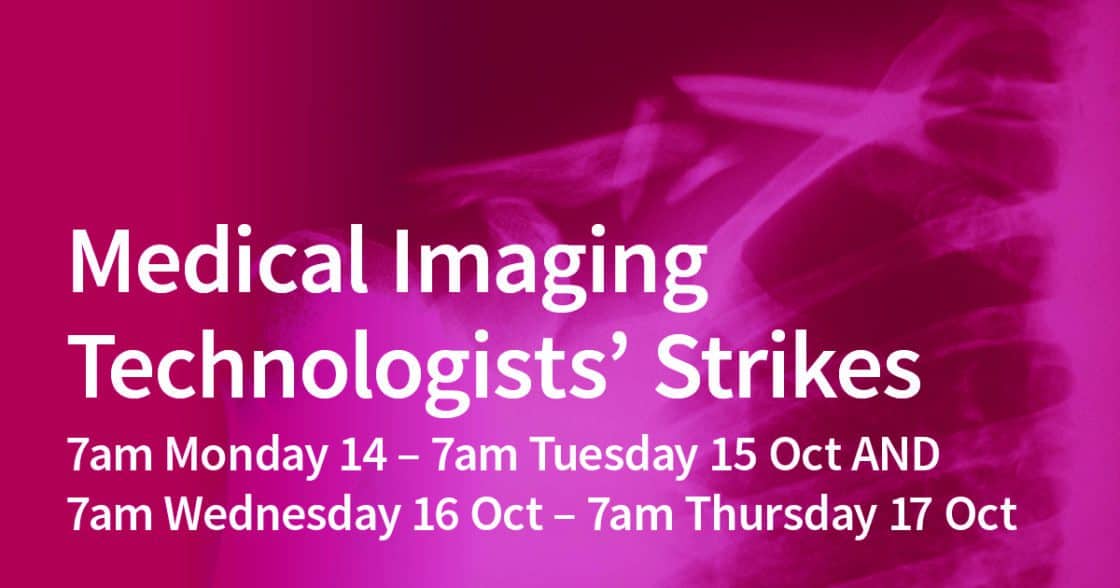Thursday 10 October 2019Media release5 minutes to read
THIS IS AN ARCHIVED PAGE. The advice and information contained in this page may not be current and it should only be used for historical reference purposes.

Two further 24 hour Medical Imaging Technologists' strikes have been planned for Monday and Wednesday next week (14 and 16 Oct).
Medical Imaging Technologists to go on strikes three and four, for two 24 hour periods from 7am Monday 14 October AND from 7am Wednesday 16 October
Canterbury DHB’s Medical Imaging Technologists (MITs) who are members of the APEX union will be going on strike for two further 24 hour periods from 7am on Monday 14 October to 7am Tuesday 15 October AND from 7am Wednesday 16 October until 7am Thursday 17 October.
MITs are the health care professionals who carry out a wide range of x-rays and scans.
Canterbury DHB Chief Medical Officer, Dr Sue Nightingale said anyone who has a pre-booked outpatient appointment that involves an x-ray or scan that has to be rebooked as a result of this industrial action will be contacted by phone or text to reschedule their appointment. Once arranged, the new appointment will stand even if the strike doesn’t go ahead.
We expect around 400 people will be affected on each strike day by having their outpatient appointment rescheduled and around 30 people on each day will need to have their surgery or procedure rescheduled due to the strike.
As part of our contingency plans, services from some private providers more extensively than usual. We may transport some hospital patients to a private provider for urgent scans or x-rays and we will be working closely with our Urgent Care practices and general practice partners to ensure we keep disruption to a minimum.
“This does mean that some people who are clinically stable may have to wait longer to have their x-ray or scan, and we apologise in advance for that.”
Anyone who needs emergency care during the 24 hour period of the strike will receive it, including any x-rays or scans necessary for safe care. Canterbury DHB has an arrangement with the union that enables staff who would otherwise be on strike, to provide emergency care if needed.
It’s important to note that sonographers who provide ultrasound scans are not affected by this strike and will continue to work as normal.
Dr Nightingale stressed that anyone who needs health advice or care should continue to make their general practice team their first port of call 24/7.
“After hours you can call your own practice, even when they’re closed. Simply follow the instructions on the answerphone to be put through to a nurse who will provide free health advice and tell you what to do and where to go if you need to be seen.
“Of course, if it’s an emergency you should call 111 as per usual,” Sue Nightingale said. “We have staff available to ensure you will receive the care you need.”
ENDS
ADDITIONAL INFORMATION FOR MEDIA
Canterbury DHB employs 144 MITs and the DHB is planning on the basis that they will all be on strike for both 24 hour periods.
The DHB’s Radiology Services operate from Christchurch Hospital Campus, Burwood and Ashburton Hospitals.
Who makes up the Medical Imaging Technologists (MIT) (radiographer) workforce?
Medical Imaging Technologists are health care professionals who specialise in acquiring images to assist Radiologists and Cardiologists and other medical specialists with medical diagnosis and treatment.
The types of imaging they perform include:
- General x-ray, including portable x-rays. This is the most common type of imaging used in medical diagnosis. It includes chest x-rays, and x-rays to diagnose broken bones.
- Fluoroscopy is a specialised type of x-ray equipment that captures real time images.
- Image Intensifiers, also produce real time images. They are used in operating theatres to help guide a variety of procedures including checking the position of a hip replacement or a broken bone. Machines that do real time x-ray imaging are also used to guide a range of interventional radiology procedures including unblocking blood vessels to the legs and treating aneurysms or draining blocked kidneys. Cardiologists also use real time imaging in the catheter lab to assess and guide unblocking the arteries of the heart.
- Bone Densitometry uses very low-dose x-rays to measures the density of bones.
- CT – A Computerised Tomography or CT scan takes x-ray images from different angles around the body and uses a computer to create ‘slice images’ that show the detail of bones and blood vessels and soft tissues inside the body.
- MRI (Magnetic Resonance Imaging) – scans your body using strong magnetic fields and radio frequency pulses – the result is a detailed image that shows internal organs and structures.
- Interventional Radiology – is a medical sub-specialty of radiology which uses minimally-invasive image-guided procedures to diagnose and treat people. An example of this is the clot retrieval service for people who have had a stroke.
- Nuclear Medicine uses small amounts of radioactive material along with x-rays from a CT scanner to make images that help detect things such as heart disease and bone tumours.
Tags Canterbury health systemStrike
Back to Health News

